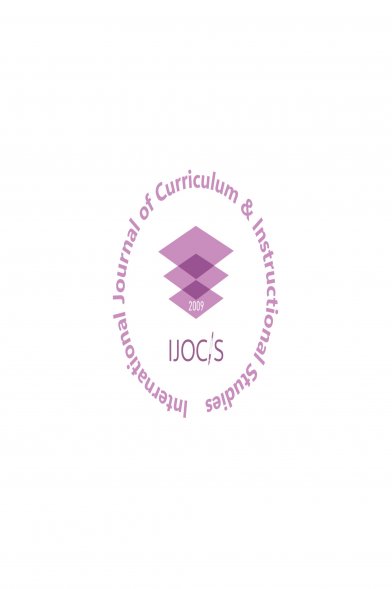A bilingual university student’s acculturation process in the United States: A linguistic case study for culturally responsive curriculum development
Amerika Birleşik Devletleri’nde iki dilli bir üniversite öğrencisinin kültürleşme süreci: Kültüre duyarlı program geliştirme için dilbilimsel bir durum çalışması
___
Anderson, P. A. (2009). Beyond language: Non-verbal communication across cultures. In L. A. Samovar, R. E. Porter, & E. R. McDaniel (Eds.), Intercultural communication: A reader (12th ed., pp. 244-250). Boston, MA: Wadsworth Cengage Learning.Arslangilay, A. S. (2018a). The reflection of immigration on school culture: A qualitative study. International Journal of Instruction, 11(2), 585-602. https://doi.org/10.12973/iji.2018.11240a
Arslangilay, A. S. (2018b). Are Turkish teacher candidates ready for migrant students? Journal of Education and Learning, 7(2), 316-329. https://doi.org/10.12973/iji.2018.11240a
Barna, L. (1994). Stumbling blocks in intercultural communication. In L. A. Samovar& R. E. Porter (Eds.), Intercultural communication: A reader (12th ed., pp. 370-379). Boston, MA: Wadsworth Cengage Learning.
Chen, G. (2009). Intercultural effectiveness. In L. A. Samovar& R. E. Porter (Eds), Intercultural communication: A reader (8th ed., pp. 370-379). Boston, MA: Wadsworth Cengage Learning.
Charlebois, J. (2009). Language, culture, and social interaction. In L. A. Samovar& R. E. Porter (Eds.), Intercultural communication: A reader (8th ed., pp. 370-379). Boston, MA: Wadsworth Cengage Learning.
Clark, D. N. (2000). Culture and customs of Korea. Wesport, Connecticut: Greendwood Press.
DeCapua, A. & Wintergerst, A.C. (2016). Crossing cultures in the language classroom (2nd ed.). New York, NY: The University of Michigan Press.
Ellis, D. G. & Maoz, I. (2009). Dialogue, argument, and cultural communication codes between Israeli- Jews and Palestinians. In L. A. Samovar, R. E. Porter, & E. R. McDaniel (Eds.), Intercultural communication: A reader (12th ed., pp. 244-250). Boston, MA: Wadsworth Cengage Learning.
Hammond, Z. L. (2015). Culturally responsive teaching and the brain: Promoting authentic engagement and rigor among culturally and linguistically diverse students. Thousand Oaks CA: Sage Publications.
Hofstede, G. J. (1980). Motivation, leadership, and organization: Do American theories apply abroad? Organizational Dynamics, 9(1), 42-63.
Hofstede, G. J. (2001). Culture's consequences: Comparing values, behaviors, institutions and organizations across nations, (2nd ed.). Thousand Oaks CA: Sage Publications.
Hofstede, G. J. (2011). Dimensionalizing cultures: The Hofstede Model in Context. Online Readings in Psychology and Culture, 2(1). https://doi.org/10.9707/2307-0919.1014.
Hooker, J. (2009). The cultural iceberg. In L. A. Samovar, R. E. Porter, & E. R. McDaniel (Eds), Intercultural communication: A reader (12th ed., pp. 59-64). Boston, MA: Wadsworth Cengage Learning.
Ishii, S., Klope, D. & Cooke, P. (2009). Worldview in intercultural communication: A religo-cosmological approach. In L. A. Samovar, R. E. Porter, & E. R. McDaniel (Eds), Intercultural communication: A reader (12th ed., pp. 18-28). Boston, MA: Wadsworth Cengage Learning.
Karcı Aktaş, C., & Gündoğdu, K. (2020). An extensive evaluation study of the English preparatory curriculum of a foreign language school. Pegem Journal of Education and Instruction, 10(1), 169- 214. https://doi.org/10.14527/pegegog.2020.007
Kohls, R. L. (2001). Learning to think Korean: A guide to living and working in Korea. Boston, MA: Intercultural Press.
Koo, J. H. & Nahm, A. C. (1997). An introduction to Korean culture. Elizabeth, NJ: Hollym International Corp.
Kumar, R. & Sethi, A. K. (2009). Communicating with Indians. In L. A. Samovar, R. E. Porter, & E. R. McDaniel (Eds), Intercultural communication: A reader (12th ed., pp. 244-250). Boston, MA: Wadsworth Cengage Learning.
Miike, Y. (2009). Harmony without uniformity: An Asiacentric worldview and its communicative implications. In L. A. Samovar, R. E. Porter, & E. R. McDaniel (Eds.), Intercultural communication: A reader (12th ed., pp. 18-28). Boston, MA: Wadsworth Cengage Learning.
Nisbett, R. E. (2009). Living together versus going it alone. In L. A. Samovar, R. E. Porter, & E. R. McDaniel (Eds), Intercultural communication: A reader (12th ed., pp. 18-28). Boston, MA: Wadsworth Cengage Learning.
Ogbu, J. (1987). Variability in minority responses to schooling: Nonimmigrants vs immigrants. In G. Spinler & L. Spinler (Eds.), Interpretive ethnography in education (pp. 255-280). Hillsdale, NJ: Lawrence Erlbaum.
Schmidt, R. W. (1990). The role of consciousness in second language learning. Applied Linguistics, 11(2), 129-158.
Storti, C. (1998). Figuring foreigners out: A practical guide. Yarmouth, ME: Intercultural Press, Inc.
Wolcott, H. F. (2008). Etnography: A way of seeing. Walnut Creek, CA: AltaMira Press.
- ISSN: 2146-3638
- Yayın Aralığı: 2
- Başlangıç: 2011
- Yayıncı: Eğitim Programları ve Öğretim Derneği
Şule Betül TOSUNTAŞ, Şahin DANIŞMAN
English teachers’ perceptions of the middle school English language curriculum
Öğretim strateji, yöntem ve tekniklerinin yaratıcı düşünmeye etkisi: Bir metaanaliz çalışması
Burcu GÜRKAN, Sevda DOLAPÇIOĞLU
İngilizce öğretmenlerinin ortaokul İngilizce dersi öğretim programı ile ilgili algıları
Merve YILDIRIM SEHERYELİ, Selahattin GELBAL
Ümmühan ORMANCI, Ali Günay BALIM, Sevinç KAÇAR, Ali Günay BALIM, Erkan ÖZCAN
Merve YILDIRIM SEHERYELİ, Selahattin GELBAL
Ali GÜNAY BALIM, ÜMMÜHAN ORMANCI, SEVİNÇ KAÇAR, Erkan ÖZCAN, ALİ GÜNAY BALIM
